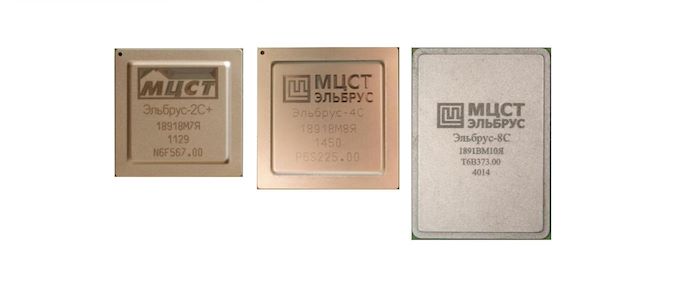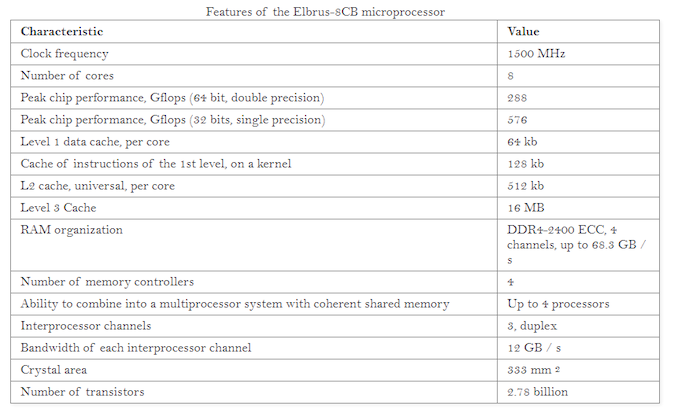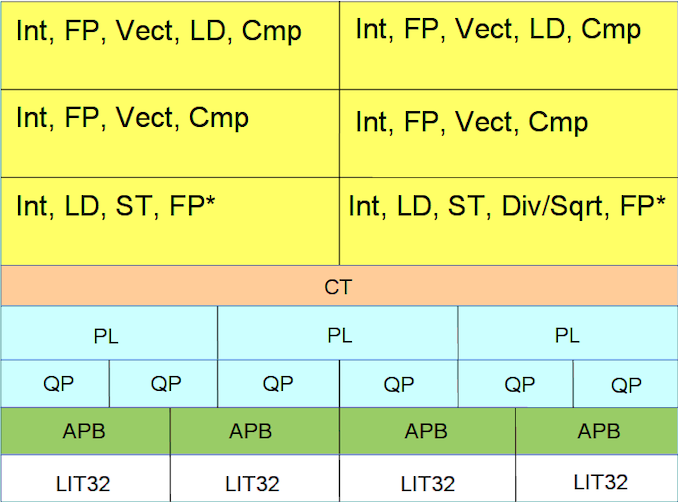Russia’s Elbrus 8CB Microarchitecture: 8-core VLIW on TSMC 28nm
by Dr. Ian Cutress on June 1, 2020 8:00 AM EST
All of the world’s major superpowers have a vested interest in building their own custom silicon processors. The vital ingredient to this allows the superpower to wean itself off of US-based processors, guarantee there are no supplemental backdoors, and if needed add their own. As we have seen with China, custom chip designs, x86-based joint ventures, or Arm derivatives seem to be the order of the day. So in comes Russia, with its custom Elbrus VLIW design that seems to have its roots in SPARC.
Russia has been creating processors called Elbrus for a number of years now. For those of us outside Russia, it has mostly been a big question mark as to what is actually under the hood – these chips are built for custom servers and office PCs, often at the direction of the Russian government and its requirements. We have had glimpses of the design, thanks to documents from Russian supercomputing events, however these are a few years old now. If you are not in Russia, you are unlikely to ever get your hands on one at any rate. However, it recently came to our attention of a new programming guide listed online for the latest Elbrus-8CB processor designs.
The latest Elbrus-8CB chip, as detailed in the new online programming guide published this week, built on TSMC’s 28nm, is a 333 mm2 design featuring 8 cores at 1.5 GHz. Peak throughput according to the documents states 576 GFLOPs of single precision, with the chip offering four channels of DDR4-2400, good for 68.3 GB/s. The L1 and L2 caches are private, with a 64 kB L1-D cache, a 128 kB L1-I cache, and a 512 kB L2 cache. The L3 cache is shared between the cores, at 2 MB/core for a total of 16 MB. The processor also supports 4-way server multiprocessor combinations, although it does not say on what protocol or what bandwidth.
It is a compiler focused design, much like some other complex chips, in that most of the optimizations happen at the compiler level. Based on compiler first designs in the past, that typically does not make for a successful product. Documents from 2015 state that a continuing goal of the Elbrus design is x86 and x86-64 binary translation with only a 20% overhead, allowing full support for x86 code as well as x86 operating systems, including Windows 7 (this may have been updated since 2015).
The core has six execution ports, with many ports being multi-capable. For example, four of the ports can be load ports, and two of the ports can be store ports, but all of them can do integer operations and most can do floating point operations. Four of the ports can do comparison operations, and those four ports can also do vector compute.
This short news post is not meant to be a complete breakdown of the Elbrus capabilities – we have amusingly joked internally at what frequency a Cortex X1 with x86 translation would match the capabilities of the 8-core Elbrus, however users who want to get to grips with the design can open and read the documentation at the following address:
http://ftp.altlinux.org/pub/people/mike/elbrus/docs/elbrus_prog/html/index.html
The bigger question is going to be how likely any of these state-funded processor development projects are going to succeed at scale. State-funded groups should, theoretically, be the best funded, however even with all the money in the world, engineers are still required to get things done. Even if there ends up being a new super-CPU for a given superpower, there will always be vested interests in an amount of security though obscurity, especially if the hardware is designed specifically to cater to state-secret levels of compute. There's also the added complication of the US government tightening its screws around TSMC and ASML to not accept orders from specific companies - any plans to expand those boundaries could occur, depending how good the products are or how threatened some nations involved feel.
Source: Blu (Twitter)














93 Comments
View All Comments
mode_13h - Tuesday, June 2, 2020 - link
I wasn't familiar with that site. Thanks for sharing!mode_13h - Monday, June 1, 2020 - link
Cool. Thanks for that!mshigorin - Monday, June 1, 2020 - link
Привет :-)mshigorin - Monday, June 1, 2020 - link
Thank you for an interesting article; a couple comments of a guy responsible for e2k-alt-linux (and someone who works on an dualseat 801-PC routinely).> Elbrus VLIW design [...] roots in SPARC
Actually not; MCST JSC started out together with Sun Microsystems and they still design and make SPARC chips either (search for MCST R150/R500/R1000/R2000) *but* Elbrus' roots were in Elbrus supercomputer systems from 1970s, VLIW is orthogonal enough to superscalar.
> If you are not in Russia, you are unlikely to ever
> get your hands on one at any rate.
This is true, at least today.
> new online programming guide published this week
Well this is just an unpacked copy of the original one (CC BY 4.0 so I felt like doing that): http://mcst.ru/elbrus_prog -- while at that, I've just added a small README.txt with several related links to docs/ subdirectory.
> 4-way server multiprocessor combinations, although
> it does not say on what protocol or what bandwidth
Those 3 inter-CPU links per chip are specified at 16 GB/s, see http://mcst.ru/elbrus-8cb ("Характеристики" tab, "Масштабируемость" line); just like the previous 8c -- but 8CB (v5) is a gradual design improvement unlike 4c->8c jump (v3 had 4 cores @ 800 MHz, v4 has 8 better cores @ 1300 MHz).
> a compiler focused design, much like Intel’s Itanium
Rather vice versa -- but Intel couldn't even implement properly what they stole (yes, stole) along with Prof. Babayan and other MCST folks back in the hard times.
> State-funded groups should, theoretically, be the best funded
In practice, theory and practice differ more than they should in theory, they say... so far MCST managed to get impressive engineering results out with a tiny bit of funds Intel/AMD spend on marketing.
> US government tightening its screws
Reads like just sending another boomerang to return... they've made an intervention into former Ukraine where I used to grow up (and yes, US directly brewed, supported and organized neonazis there, just in case anyone missed that).
God help all the people of good will in America that day when these boomerangs start to flock on their way back.
But today, just thank you :-)
Ian Cutress - Monday, June 1, 2020 - link
Hey mshigorin, thanks for unpacking it for the web, It gives a small insight into something we don't normally see. The language/script barrier can be somewhat of an issue. If you have anything similar / info that might help, feel free to dump into by inbox: ian@anandtech.com.Perhaps at some point we might get access to a chip and give it a test.
mshigorin - Tuesday, June 2, 2020 - link
Thanks, noted. I hope -- and work -- to get that point closer :-)wishgranter - Monday, June 1, 2020 - link
> a compiler focused design, much like Intel’s ItaniumRather vice versa -- but Intel couldn't even implement properly what they stole (yes, stole) along with Prof. Babayan and other MCST folks back in the hard times.
Hi mr mshigorin
Quite interesting infos there and this one exceptional, could you explain a bit more ?
bagamut - Tuesday, June 2, 2020 - link
That's a long old story...After USSR collapse one of the leading architects of the Soviet Elbrus supercomputers Dr. Vladimir Pentkovski worked for Intel in 90th. An many others.
Prof. Boris Babayan from 1992 to 2004 held senior positions in the MCST and Elbrus International, leading development on Elbrus architecture. He worked for Transmeta, Sun, and since August 2004, Babayan is the Director of Architecture for the Software and Solutions Group in Intel Corporation.
bagamut - Tuesday, June 2, 2020 - link
And 500 MCST engineers also moved to Intel with Babayan. And IP, and patents...boeush - Tuesday, June 2, 2020 - link
> US government tightening its screwsReads like just sending another boomerang to return... they've made an intervention into former Ukraine where I used to grow up (and yes, US directly brewed, supported and organized neonazis there, just in case anyone missed that).
Ah - yet another proud victim of Putin's state disinformation machine... More's the pity - for you, and for Russia. As long as you all keep falling for the same old Soviet-style tricks, you'll just keep on digging that hole of yours ever deeper. Eventually, the walls will collapse on you.